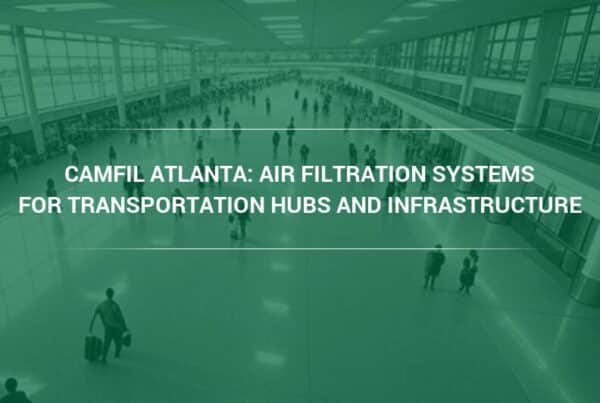The 2023 Allergy Capitals Report, released in March, named Tulsa and Oklahoma City among the top five worst allergy seasons in the country, with Oklahoma ranked at number four and Tulsa at number five.
The report, conducted by the Asthma and Allergy Foundation of America (AAFA), examined data from NASA on pollen levels along with statistics about over-the-counter medication usage and access to allergy specialists to determine which of the United States’ 100 most populous cities has the worst allergy season. Oklahoma City has earned a high-ranking spot for seven consecutive years and Tulsa joined it in the top 10 for the first time in 2020.
In this article, air quality experts from Camfil explain the Allergy Capitals Report, explore why Tulsa’s allergy season is so severe, and discuss potential solutions for seasonal allergies in the region.
What are the symptoms of seasonal allergies?
Allergic reactions to pollen and mold, commonly known as hay fever, seasonal allergies, or seasonal allergic rhinitis medically, occur when a person’s immune system reacts negatively with inhaled pollen particles in the air. Although hay fever is usually associated with the season of spring, different kinds of plants release pollen at different times of year, meaning that some places, particularly those with warmer climates, experience some kind of pollen allergy year-round.
Symptoms of pollen allergies vary in severity from person to person, with some experiencing only mild discomfort while others may need specialized medical treatment from an immunologist due to the disruption in their life that pollen allergies cause. The most common symptoms of pollen allergies are:
- Sneezing
- Runny nose (thinner mucus) or stuffy nose (thicker mucus)
- Sinus irritation
- Red, itchy, or watery eyes
- Itchy ears, nose, and mouth
- Sore or scratchy throat
- Itchy skin, which may lead to visible hives or rashes
- Fatigue
What is the Allergy Capitals Report and Why Does Tulsa Rank So Highly?
The Allergy Capitals report, released annually by the Asthma and Allergy Foundation of America (AAFA), is an analysis of data from the 100 most populous American cities to determine the severity of each city’s allergy season. The cities are then ranked based on their score, which is based on pollen and mold spore count, over-the-counter medication use, and accessibility of allergists and immunologists in the area.
Tulsa was ranked the fifth worst city for allergy sufferers, while Oklahoma City just two hours away was ranked number four on the list. Both cities have notably high pollen counts (showing that the presence of allergens is high), high over-the-counter medication usage (indicating that many people are affected by the presence of allergens, and moderate availability of allergists, immunologists, and other relevant specialists (meaning that it can be difficult to access medical treatment for allergy symptoms for those who cannot find relief from over-the-counter allergy medications).
What Are the Most Common Seasonal Allergens in Tulsa?
Tulsa’s high pollen count comes mostly from tree pollen, though some species of weed and grass significantly add to pollen levels. Common tree allergies in Tulsa include mesquite, elm, juniper, mulberry, and ash. Weed species like ragweed, plantain, and nettle are also considered common seasonal allergens in the area. Finally, grasses like Bermuda, Kentucky bluegrass, and sweet vernal grass all can pose a risk of allergy symptoms. The following trees are the most common pollen producers that cause allergies in the Tulsa area:
- Maple
- Hackberry
- Pecan
- Hickory
- Red Cedar
- Ash
- Walnut
- Mulberry
- Oak
When is Allergy Season in Tulsa?
Because the primary allergens in Tulsa and surrounding areas are trees, allergy season peaks significantly in the spring and tapers off through the summer, with only a handful of plant species pollinating during the fall and winter months. In recent years, Tulsa’s allergy season has been starting as early as February.
What Factors Make Allergy Season Worse in Tulsa?
Air quality in Tulsa and surrounding areas is good during most times of the year, according to the Air Quality Index, but other factors may increase the severity of allergy symptoms, such as:
- Tulsa gets more rain annually than the United States average; rain not only allows more plants to propagate but can also trigger plants to release pollen in bursts.
- The climate of Tulsa is characterized by relatively rapid shifts in temperature and mild winters, which can cause plants to begin pollinating earlier in the year than in other colder climates.
- Rising temperatures in recent years have made allergy season in Tulsa begin earlier and last longer.
- Oklahoma experiences significantly more wind, including tornadoes, than other parts of the country, which disperses pollen far away from its source.
How to Minimize Allergy Symptoms in Tulsa, OK, This Spring
Unfortunately, it is difficult for allergy sufferers to completely avoid pollen and eliminate hay fever symptoms, but the following tips help minimize spring allergy symptoms:
- Stay inside when it’s windy.
- Keep track of pollen counts in your area.
- Bathe or shower after coming in from outdoors.
- Change and wash your clothes after extended periods of time outdoors.
- Keep doors and windows closed during pollen peaks, particularly if it is windy
- Vacuum frequently to prevent pollen from gathering on surfaces and upholstery in your home.
- Use antihistamines and anti-inflammatory medications when necessary.
- Protect your home with HEPA filters.
How Do Air Purifiers Help with Seasonal Allergies?
Individuals with pollen allergies often spend extended periods indoors to steer clear of outdoor pollen. While this is frequently recommended for severe allergies, indoor spaces may not be as safe as you presume.
Indoor spaces can be up to fifty times more polluted than the surrounding ambient (outdoor) air due to poor ventilation, which allows pollutants to build up in the stagnant air, and in buildings where air is recirculated without adequate air filtration. Pollen is an indoor air pollutant and can build up in homes, offices, classrooms, and other indoor environments in the same manner as other pollutants.
Importantly, the panel filters in most HVAC systems are only effective enough to prevent damage to the equipment but do not stop smaller particles such as pollen from entering the airstream and being inhaled by building occupants.
Air purifiers with factory-tested HEPA filters are the ultimate solution for seasonal allergies in homes, offices, classrooms, gyms, and commercial and public buildings to remove pollen from the air and provide allergy sufferers with clean, comfortable air. They are independent of the building’s HVAC system, so no specific HVAC requirements are necessary. Additionally, air purifiers easily plug into standard electrical outlets, allowing for simple installation without professional assistance.
Using a high-quality air purifier that utilizes tested and certified HEPA filters, like Camfil’s City M, can immensely help to mitigate indoor pollen concentrations that often cause allergy symptoms. Besides the HEPA filters, this air purifier incorporates an activated carbon filter that has the added ability to capture and diminish irritants such as household odors, fumes, and VOCs, which can cause respiratory irritation.
The installation of an efficient air purifier like the City M, along with medication and immunotherapy, can help you effectively manage your allergies this season and enjoy spring more comfortably.
About Camfil Clean Air Solutions
For more than half a century, Camfil has been helping people breathe cleaner air. As a leading manufacturer of premium clean air solutions, we provide commercial and industrial systems for air filtration and air pollution control that improve worker and equipment productivity, minimize energy use, and benefit human health and the environment. We firmly believe that the best solutions for our customers are the best solutions for our planet, too. That’s why every step of the way – from design to delivery and across the product life cycle – we consider the impact of what we do on people and on the world around us. Through a fresh approach to problem-solving, innovative design, precise process control, and a strong customer focus we aim to conserve more, use less and find better ways – so we can all breathe easier.
The Camfil Group is headquartered in Stockholm, Sweden, and has 31 manufacturing sites, six R&D centers, local sales offices in 35+ countries, and about 5,200 employees and growing. We proudly serve and support customers in a wide variety of industries and in communities across the world. To discover how Camfil USA can help you to protect people, processes and the environment, visit us at www.camfil.us/
##
Media Contact:
Lynne Laake
Camfil USA Air Filters
T: 888.599.6620
E: Lynne.Laake@camfil.com
F: Friend Camfil USA on Facebook
T: Follow Camfil USA on Twitter
Y: Watch Camfil Videos on YouTube
L: Follow our LinkedIn Page
Sources:
http://pollen.utulsa.edu/Spring-Pollen.html



